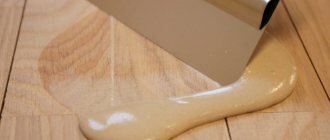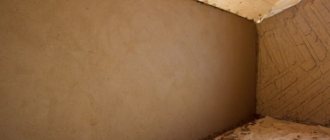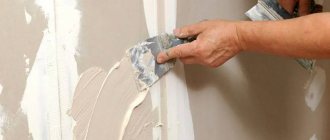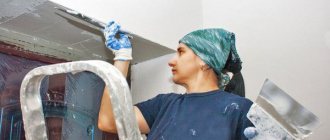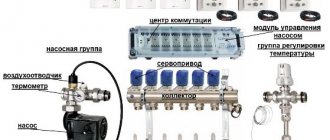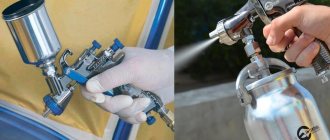11250 1 7
mark_kr January 17, 2017 Specialization: professional in the field of construction and repair (full cycle of finishing work, both internal and external, from sewerage to electrical and finishing work), installation of window structures. Hobbies: see the column “SPECIALIZATION AND SKILLS”
When preparing parquet for polishing or varnishing, different compositions are used
When filling cracks and repairing natural wood floors, a special putty for parquet is used: you can put any covering in order with your own hands. In this article I will tell you how to make your own putty mixture, what ready-made material to choose for the job and how to use it correctly.
Functional purpose of parquet putty
Putty for parquet after drying.
It is recommended to use the putty mixture:
- for sealing gaps and cracks between individual parquet planks. These defects can occur if the floor covering is not installed correctly, including during operation. For example, after changing the microclimate in the room, changing temperature parameters and humidity. Puttying of planks is permitted during sanding when varnish is applied.
- to give the flooring a presentable appearance after use, when chips, cracks, stains and other defects are noticeable. In this case, the damaged area is first cleaned, and then the tone is leveled by applying putty.
The importance of technology compliance
Each layer of putty should harden well. Only in this case can you notice some shortcomings of the work.
Important! After a single application, the surface should be inspected. If there are areas of subsidence of the putty, the solution must be reapplied.
Some defects after the main restoration need to be eliminated with special means. To do this, use an artist's palette knife or putty for laminate flooring, which goes well with the wood flooring. The composition is filled into the cracks using a wax melter, and problem areas are sanded and polished. Parquet grout is also used. The final result will depend on the quality of the putty and compliance with the technological process.
Putty composition and its varieties
Preparation of floor putty
Depending on the purpose, parquet putty can be:
- parquet starting or base, which is used for “rough” elimination of noticeable holes and irregularities;
- the finishing putty mixture is used at the final stage to final level the floor surface;
- A universal putty composition for all types of wood is used simultaneously at the initial and final stages of repair. In this case, they perform both “rough” work and final leveling of the floor.
Depending on the composition, putties are divided into types:
- gypsum mixture has earned popularity due to its universal purpose. Plus, this composition provides reliable adhesion to the floor surface and has a low cost. They are used for both “rough” work and for final leveling of parquet.
Gypsum putty mixture for parquet
- Oil putty can be used for various types of wood. A significant disadvantage of this type of composition is the drying time due to the presence of oil.
- acrylic putty for parquet is used for work related to the removal of small defects in the floor covering. This mixture is environmentally friendly, elastic and resistant to mechanical stress. A significant disadvantage of putty is the low adhesion of the mixture to the edges of the parquet planks. During operation, the gaps increase, accompanied by the putty material falling out of the cracks.
Acrylic putty
- alkyd putty is made on the basis of flax oil, soybean and others. It is viscous, elastic and amenable to grinding. Used for finishing work.
- latex mixture for parquet is recommended for final decorating work. In this case, it can be used for unevenness of up to two millimeters. Otherwise, the surface layer of the parquet may crack. This mixture adheres perfectly to the surface, which is smooth and uniform. Plus, it’s worth noting the vapor-tight characteristics of latex floor putty. The cost of such products exceeds the price of standard gypsum building materials.
- the mixture or dispersion requires modification of the composition. In this case, there is no need to purchase a special dye. You can take the remaining dust from the top parquet layer and mix it with the mixture. As a result, you will have an excellent material for leveling parquet planks with recesses of up to 6 mm. This is one of the cheapest ways to restore the appearance of flooring.
Dispersion for parquet
Depending on the composition of the putty base, there are:
- water-based putty is characterized by drying speed and environmental safety in terms of the complete absence of toxic fumes;
Important! You should not use water-based putty on hard wood, for example, chestnut, oak or cedar.
- Solvent-based putty is considered a universal option for puttying parquet. It can be used on all wood species, unlike a water-based composition. Significant disadvantages of the material include the flammability of the substance and its pungent odor.
How to choose the right putty?
With all the variety of options, you need to choose compositions according to the following principles:
Primer for parquet varnish: types, application rules and best manufacturers
- Plastic. This will make it easier to apply the mixture to the surface.
- Short drying time and good sanding properties.
- The composition should contain a minimum amount of toxic components to reduce the risk of the release of negative fumes when the room temperature rises.
- After drying, the composition should not shrink, fall out of the crack, crack, flake, or crumble.
- High quality adhesion to a smooth surface is a must - the better the adhesion, the longer the putty lasts on the parquet.
Advice! Oil compositions are difficult to work with, so you must follow all the manufacturer’s recommendations. If you are careless, the mixture will quickly crumble and begin to fall out of the cracks.
Most often, compositions with an acrylic or polymer binder are sold in the form of a white/colorless liquid. To prepare the mass, wood dust is added to the base. It would be ideal if the wood filler is the same type of wood as the parquet. That is, putty for oak parquet must contain oak sawdust, then after drying the surface of the coating will be uniform.
When purchasing a mixture, you should look at the consumption - the standard consumption of the composition is 30-100 ml of the base mixture per 1 m2 for single-layer application. The volume is calculated individually taking into account the condition of the floor covering.
The first method of creating your own putty for parquet
In this case, you should prepare PVA glue and wood dust formed after sanding the parquet surface. By mixing the components one to one, you will get a plastic mass.
The main advantages of this type of composition include:
- perfect color match;
- ease of making the mixture;
- no difficulties in the process of puttying work;
- acceptable price.
Important! The putty mixture, which involves the use of PVA glue, is not resistant to mechanical stress. In this case, during operation, the surface layer may crack and the putty may fall out of the cracks.
Basic mistakes when working
It happens that the completed repairs soon begin to deteriorate and the putty areas are destroyed. The main reason is a violation of the work technology when sealing chips, crevices, cracks, as well as when laying parquet. Often the putty does not last long if the individual lamellas are poorly secured. They become loose and the mixture cannot stay in the gap.
Another possible reason for the poor quality of the repair could be incorrect production of the putty or violation of the proportions of mixing the components. Problems can also arise when applying too thin a layer or with a small number of layers, or when the drying time of the material is not observed.
Second method of creating mass
Components used:
- drying oil - 500 g;
- animal glue - 100 g;
- desiccant in liquid form - 25 g;
- liquid soap;
- chalk.
Method of preparing the mixture
Initially, it is recommended to heat the animal fat to a liquid state. And the remaining components of the homemade putty are poured into it and poured into it. In this case, chalk in powder form is added until the consistency of “liquid sour cream” is obtained.
Due to the fact that the substance ends up being transparent, it can be used to fill parquet of any type of wood. But please note that this composition is applied warm.
Important! In construction stores there is a special liquid mass, adding wood dust to which you will have a ready-made substance for puttingtying parquet.
We tidy up the floor in every possible way
Keep in mind that wood, as a natural material, can both shrink and expand due to violation of operating rules, as well as moisture ingress; cracks can form between the boards. The appearance of a cracked or stained floor will definitely make you think about restoration. So, dirty spots and darkened areas can be cleaned, and cracks can be filled with putty.
Floors made from tongue and groove boards can also be tidied up.
It is also important to consider the humidity and temperature of your room. After all, high humidity in the room can lead to a damaged surface.
And if the house has central heating, then it is allowed that the boards can contain a maximum of 10% moisture. A chisel and a hammer will help to repair such a floor - we insert a chisel between the boards, hit it with a hammer, and insert a hacksaw blade into the crack that has formed and saw along the board itself. In this case, bad boards are cut along the grain.
You can also fight cracks using thin planks and sawdust from wood. If you mix them with varnish or paint, you can repair cracks in the floor. To prepare a special composition, you need to take 4 parts of sawdust and mix with 1 part of varnish or paint of the desired color. If the floor has not been painted before, and you are planning to seal the cracks, then you can use sawdust putty. In this case, putty for parquet is prepared as follows: take a five-liter bucket, fill it to the top with sawdust and pour boiling water over it. The homogeneous mass should cool, after which wallpaper glue is added to it and continued mixing. After this, the floor is cleaned with a spatula, and the cracks are sealed.
Correct application of putty mass
Work on applying putty
Before starting work on puttying parquet, it is recommended to thoroughly clean the floor surface from dust and dirt using wet cleaning. In this case, parquet puttying is carried out during any work, both during the initial installation process and during the repair of individual planks.
The mixture is applied using a standard metal spatula using small circular or semicircular movements. This is the only way to ensure that the seams and gaps are filled with putty material. After the surface has completely dried, it can be polished.
Doing parquet putty with your own hands is a simple task. The main thing here is to choose the right color of the mass or create it yourself.
Average score of ratings is more than 0
Share link
Comments There are no comments yet, but you could be the first...
When does it become necessary to use putty?
Before starting restoration work on parquet, it is necessary to find out what materials need to be used to repair defects and flaws that appeared during operation.
If everything is clear with the finishing coating, then the question regarding putty remains unclear for many owners. According to the recommendations of experts, it is appropriate to use it in the following cases: • after laying a new parquet flooring to seal the cracks between the tiles;
• after prolonged use of parquet, when potholes, chips, and cracks become visible on the surface with the naked eye.
You can do without putty when laying a floor with parquet boards. Usually it is not fixed rigidly, which ensures free movement along the surface under different amplitudes. If you treat the cracks with the highest quality putty, then when the boards move while walking on them, the seal will fall out. Also, the installation of solid boards with a chamfer is avoided without the puttying procedure due to changes in the structure of the wood during the drying process.
Aftercare
Any material has vulnerabilities. If we are talking about parquet or any other wooden covering, water should not be allowed to get on it. An apartment flooded by neighbors above may require urgent repairs, since there is a high probability that the slats may rise. If water flows from the ceiling, you can use containers to collect it, and the floor should be covered with film.
Use only proven parquet care products. Aggressive detergents can damage the surface or dissolve the varnish coating. It will take quite a long time to recover. Therefore, you should not spare money on professional “cosmetics” for the floor, which can be bought in specialized stores.
The interior is constantly changing. New furniture and appliances appear in the apartment. As already mentioned, mechanical stress can damage the parquet and crack dried putty. When bringing or removing furniture from/to the apartment, it is better to cover the floor with old blankets or cloth. Such solutions will help soften possible impacts on the coating.
If you need to polish, repair or restore a damaged area of the floor, you can use the same universal materials mentioned above. It is only necessary to monitor their expiration date. The preparation of mixtures is done strictly according to the instructions.
You will see how to sand parquet yourself in the next video.
Usage
Scheme of cork floors on a concrete base.
The main purpose is to level the surface before applying coating materials. It is better to putty any type of surface before painting or wallpapering.
Putty for concrete floors is used as a universal material for leveling it.
The domestic market of construction and finishing materials mainly offers putty in the form of a dry mixture. In this regard, first of all you need to mix the putty, then prepare the surface. Before filling, the coating is cleaned of grease and dirt and, if necessary, treated with a primer. The instructions on the package will help you properly dilute the putty from the dry mixture. One point should be noted here: putty for a concrete floor is carried out due to gravity, so it should be slightly thinner than a regular solution for ceilings or walls (diluted with water in a ratio of 1:5).
For waterproof surfaces, the putty is diluted a little thicker (1:3). Next, you should lay the putty in a thin, even layer on the surface. The use of a thick layer is unacceptable, as this will promote the formation of cracks. After the putty has hardened, you need to remove the excess with a spatula and level it with sandpaper. For more information on how to use a particular type of putty, it is best to read the instructions on the package. For example, putty for polystyrene foam requires preliminary degreasing of the surface and is laid in 2 layers.
Scheme of a standard floor screed.
The dry mixture must be diluted in the amount required, because after the stated time has elapsed (usually 4 hours), it will become unsuitable for use.
It is important to choose a putty according to the requirements for room humidity and drying time. There are types that can only be used indoors with low humidity levels and at a certain temperature
Before further work, you must wait until the putty on the surface is completely dry. On average, complete drying time is 24 hours.
Putting the floor requires some preparation and takes a lot of time, so it is often easier to turn to specialists.
Selecting a mixture by manufacturer
Swedish BONA
can be proud of its water-dispersed acrylic composition “Bona Mix&Fill”. This mixture refers to putties that acquire the color of the parquet being processed when dust is added to it after sanding. As for the treatment of pure wood parquet flooring, the best solution would be putty with PARKETTGRUND solvent as a base.
German Loba
It has a high-quality water-based putty that adheres well to the surface, dries quickly and has low consumption during operation. But the material, which is based on the LOBADUR Fugenkittlosung solvent, is valued, since it adheres well to wood flooring and is highly elastic.
Also in Germany, you can highlight the company Uzin, which produces quick-drying putties for any parquet. Moreover, their use on heated floors is permissible.
Italian Chimivers
produce a universal putty with universal performance characteristics and ease of sanding after the layer dries. There are varieties both water-based and solvent-based.
The varieties of mixtures used do not end there. Mixtures produced in Belarus will cost owners cheaper and without loss of quality. Qualified construction store managers will help you choose the most suitable mixture for a specific coating and room.
Work operations
For minor parquet repairs, you need to master four simple technological techniques: preparing tinted putty, simulating joints, hand scraping and foot sanding.
Cosmetic putty
You can completely dispense with preparing homemade cosmetic putty: there are a variety of restoration pastes for parquet, Bona, and others in various shades on sale. But if you have several old parquet floors lying around in your closet, the same ones that are laid on the floor, you can prepare a grout for potholes and seams that is ideal for the floor. To do this, you need to cut more sawdust with any suitable tool and mix it with parquet varnish to the consistency of sour cream. Sawdust filler can be added to epoxy varnish in a ratio of up to 4:1; it will look like plasticine.
But it makes sense to prepare putty yourself only in the case described above: to obtain an exactly matching tone, not only the species matters, but also the period of aging of the wood. If there are no exactly the same samples of wood, it is easier to buy ready-made putty or paste of a suitable shade.
Video: parquet putty
Imitation of joints
Imitation of the joints of dies on the puttied surface of the parquet is done with an ordinary awl and a metal bench ruler:
- Wait for the putty to gelatinize, i.e. it should no longer “take on”, but still be soft. For alkyd and uralkyd varnishes, gelatinization occurs within a few minutes after application and lasts about a minute, so you need to work quickly.
- Straight false joints are drawn with an awl along a ruler.
- Curved false joints are made with the edge of a ruler with slight pressure.
- False joints on hardened putty, when necessary, are scratched with an awl along a ruler or galvanized template.
For sanding sections of parquet, it is convenient to use old shoes with flat soles: sneakers, “bazaar” Chinese summer shoes, etc. Apply sandpaper number 40 (coarser) to one sole with 88 glue; on the other - number 80 (thinner), for primary and final grinding. Shuffling your feet is also somewhat tiring, but rubbing your hands while kneeling or bending over is much more difficult. And sandpaper on an elastic sole works more accurately than on a sanding block.

